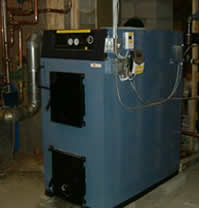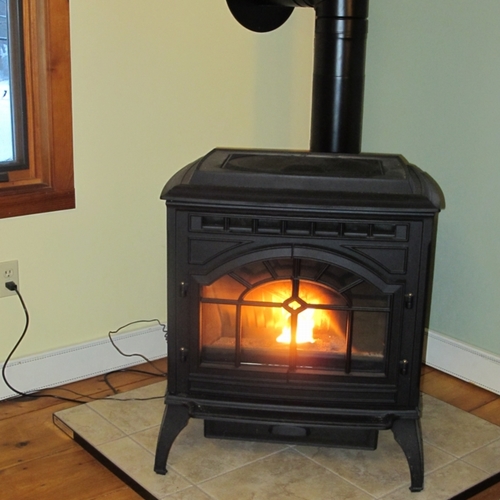For Part Two of this Green Architects’ Lounge episode, we are joined once again by our good friend Pat Coon, from Revision Heat, to discuss the topic of biomass boilers. In the second installment of this epic trilogy, Phil, Pat, and I wrap up our discussion of log gasification boilers and introduce our listeners to the concept of wood pellet boilers. If you missed Part One, you might want to give that a listen first, especially since it gives you the recipe for the perfect red Manhattan (which goes very well with this smoky topic).
In Part Two of the podcast, we discuss:
- Thermal storage for log boilers.
- Distribution. It’s a boiler and can do anything a normal boiler can.
- Maintenance. What’s involved for upkeep?
- Pellet boilers. Why consider pellet boilers? No more hauling wood.
- Pellets as fuel.
- Maintenance.
- How automated can they be?
- Fuel delivery, by the bag or by the truckload.
- Dust control and your pellet hopper.
- The quality of fuel and its output.
Stay tuned for Part Three, where we talk about cost and savings, Phil’s six-digit idea, and this episode’s song selection, “Daydreamer,” by Pete Miller.
OFFICIAL TRANSCRIPT
Phil Kaplan: So, let’s talk about crunchy green versus sexy green.
Chris Briley: Well, I’ve said this before. The threshold test is, if you ask, “Well, how do you feel about composting toilets?” And if they actually are interested in hearing what you have to say about it, then you’ve got yourself a crunchy green right there. That’s a crunchy green person. But if they’re like, “Uh, well, hey, I was, uh…” then you know what they are.
Pat Coon: Here’s what we do in our showroom. We have two doors side by side. We’ll both go into the bathroom. We’ll say, “On the left is a composting toilet, and on the right is a flush toilet.” And we’ll see where they go. Then we know what we’re going to sell them. Whip out the solar hot water literature!
Chris: So, what do we talk about cost?
Pat: Let me back up just a minute. Not all wood boilers need thermal storage tanks. If you don’t have a thermal storage tank, you’re really running your wood boiler between November and March. You’re not running it in the shoulder seasons; you’re not running it in summer.
Chris: Am I running something else?
Pat: Well, your backup system. Some clients have a woodstove that runs in the shoulder seasons.
Phil: So, are you saying you might not need a backup system?
Pat: You know, you always need a backup system. It’s prudent, and the insurance companies and the banks will want it—because you’re going to want to go away for a week and not worry about the house freezing.
Chris: And it doesn’t have to be extreme or robust, just something that’s going to save you…
Pat: Yeah, the one we just finished for the mechanical room had an electric boiler. Why spend all that money—just a cheap electric boiler that’s there for that one week when they go away. So, if you don’t have a thermal storage tank, it costs a whole lot less.
Chris: Because it’s cycling on and off more?
Pat: Well, there’s less equipment. But it’s a little less efficient. You’re also tending it every three hours irregardless; you’re not going down once a day and filling it. You’re playing with it more; it’s a more active experience.
Phil: My question is: distribution. Tell us a little bit about that.
Pat: Any type of distribution works fine.
Chris: Really? But it’s coming off as water, right? So, you’re doing water to air, or water to hydronic, in some way.
Pat: Yeah. There has never been a distribution system that we couldn’t attach to, so if you’ve got forced air, we can put a coil in a forced air system. If you’ve got baseboard, we can do that. Radiant floors actually work really well, because they let you pull the tank down further and empty the tank. Distribution is not an issue. The only time it can be a problem is if the house is really under-distributed. You really want to be able to run 150-degree water.
Chris: About the lower tank, that brings up maintenance. What kind of maintenance is one expecting, because these things are heavy. They go in the basement; they don’t go in the third-floor attic or anything like that.
Phil: They’re really robust. On the tank, with a thermal storage tank, once a year you check the pH and the water level—you have to add 20 to 30 gallons of water. So, once a year you do that. Of course, you have to clean them, and different boilers can be cleaned in different ways. They’re easy or hard to clean. Once a cord of wood, you have to open it up and scrub it out. The new, fancy ones you clean by shaking a lever. The older ones, you have to open some wing nuts; it takes about 10 minutes. Feeding them and cleaning them are small tasks.
Chris: So, now let’s shift the conversation. We’ve talked about logs as a fuel source. Pat, what if I don’t want to schlep the logs? I love everything you just said. I love the renewability of wood, but I don’t want to schlep the logs. Isn’t there a way, Pat…?
Pat: Well, it’s funny you should mention it. Have you ever considered a wood pellet boiler?
Chris: You mean the little thing that’s like a woodstove?
Pat: Yes, they have pellet boilers—down in the basement, central, hydronic, automated systems.
Chris: But then I have to schlep all the pellets, don’t I?
Pat: Not anymore. Wood pellets are nothing more than sawdust, which is passed through an extruder—a big drum with holes on the outside that crushes the sawdust and pushes it through the holes. And the lignan in the wood gets squirted out of the cells; that’s what gives it a sheen and holds it together.
Chris: So, can you do that with leaves? Just kidding.
Phil: So that’s what the sheen is from? I wondered if they were polishing those things.
Pat: Everyone thinks they put a little petroleum on them to hold them together, but no, that’s just the lignan from the wood. So, the whole idea of pellets—why would you do this? One is, when you make the wood into sawdust, you can dry it really easily. For cordwood, nice, dry firewood has 20% moisture content. For pellets, it’s down to around 7%. So you can get a lot of the moisture out, and that makes it burn more efficiently on site and makes it easier to transport. When you “densify” it—when you squish it back together again—you can ship it more easily because now it’s much smaller: about half the volume of cordwood.
Chris: It’s also a gasification process, is it not? For firing the pellets?
Pat: What gasification did was have multiple zones. For most pellet boilers, they don’t have separate combustion chambers; usually there’s one chamber with a combustion zone and a secondary combustion zone, and a heat extraction chamber. So, usually they’re two-chamber boilers as opposed to three, but they still do the same thing. They get up to really high temperatures, they get all the energy out of the wood and suck it all out.
Chris: So, will it yield the same kind of exhaust as a gasification boiler, or will it be slightly more…
Pat: A little cleaner, fewer particulates, higher—a really good wood boiler has about the same thermal efficiency as a really good pellet boiler. But it’s easier to get good efficiencies out of a pellet boiler than a wood boiler. The other thing about the fuel is that it’s uniform, so it’s easy to design an augur system to transport it because it’s only going to be so fat, or so long; it’s going to have certain properties that are knowable.
Phil: Speak a little bit about the augur system. You don’t open this up and dump shovelfuls of this in and light it in the same way.
Pat: Well, you can. This is an important thing to know about pellet boilers. There’s a huge range of how automated the boilers are. When you think about what a boiler does, it can transport the fuel or not, it can ignite itself or not, and it can clean itself or not. Some boilers have all these things automated…—oh, and it can de-ash itself or not. The completely automated boilers have a truck that pneumatically blows pellets into a bin, and then the boiler pulls pellets out of the bin, either through an augur or a vacuum system. They all combust the pellets, but some of the boilers will turn themselves on and off; others, you do that manually. Some of the boilers clean themselves; others, you do it manually. And some pull the ashes right outside.
Phil: My guess is the market for the pellet boilers is what you said: The people who say, “I like the idea, but it’s a little too much work.” The pellet boilers people are most interested in, I imagine, are the ones that do most of this work for you—but still, you get the advantage of wood.
Pat: These are relatively new on the market, so we don’t have enough of a record to know which way they’re going to go. Coming up in the marketplace we have a boiler that is bulk-fed, so you don’t have to carry pellets into your basement; those are blown into a hopper in the basement. They’re transported from the hopper to the boiler automatically. Once a week, or once every other week, you’ll go down to the boiler and shake a little lever. It’ll take two minutes—actually, it will take five seconds. There’s a mechanism inside; you’re knocking the ash down. And once a month, maybe six weeks, you have to open the boiler and pull the ash out. That boiler costs about $7,000 less than a boiler that does those two things for you. So, that’s where I think the market is. Yeah, you can have it completely automated, and some people will want to. Or you can have a little bit of interaction, and save a bunch of money. For the last eight years we’ve been selling a really nice boiler that you have to bag feed, you have to de-ash, and you have to clean—and guess what, we didn’t sell that many of those.
Phil: Let’s cover all the things we did with a wood boiler, because I want to see these things side by side. What does it look like? So, you’ve added a hopper but you’ve gotten rid of the actual cord of wood sitting in my basement.
Pat: It doesn’t look that much bigger than an oil boiler—it’s a little bigger…
Phil: The hopper is.
Pat: No, the boiler itself. You want to size the hopper for no more than four deliveries a year. A ton of pellets is 40 lb. per cubic foot. About 4 by 4 by 5 is what a ton is. So, a house that burns 900 gallons of oil would burn 8 tons of pellets. You wouldn’t want a hopper less than 2 tons; you’d probably want it closer to 4 tons.
Chris: And you’d get a couple of refills throughout the year. A truck drives up, takes out a hose much like an oil hose only much thicker—static lined so it doesn’t ignite any dust—hooks it up to a big fitting on your house, and then he just turns it on and blows pellets into the hopper. Does it whistle?
Pat: No, it hums.
Phil: How about noise?
Pat: Of the boilers? They’re much quieter than oil boilers. The fans are much more gentle.
Chris: How about dust? I’ve got this hopper, and the truck is going to blow sawdusty pellets into my basement. It’s very similar to coal; only instead of open air, it’s contained, right?
Pat: There’s all different kinds of hoppers. We’ve used metal hoppers, we’ve used plywood hoppers built on site, we’ve used cloth hoppers. We’ve designed a couple of hopper rooms, which have an augur on the bottom. Cloth hoppers are cool because they’re designed for the purpose and you only need one hose; you blow the pellets in, and the hopper lets air out, but not dust. Like a vacuum bag.
Phil: Does this have to sit in conditioned space?
Pat: No. We’ve just designed our first two silo systems, and they sit outside. We get our silos from agriculture supply houses.
Phil: I see an architectural opportunity here.
Pat: We were talking about that for one of the jobs. I said, “We can build this building and make one of those silo rooms. It’s going to be really expensive, and you’ll have to build a building for it. Or you can just buy a hopper. 7,000 bucks and you’re done.” And they were like, “We don’t like the way it looks.”
Chris: Hire an architect, and we’ll make it look great!
Pat: Well, I suggested they tape pine needles to it. A lot of glue…
Chris: Like I said, hire an architect…
Phil: Pine needles?
Pat: Well, it was in the woods, to kind of blend in a little bit…
Chris: Should the boiler be in conditioned space?
Pat: We haven’t done a ton of these. We’ve done about two dozen of the old-school types and five of the fully automated types. So, we’ve designed our first direct heating system with the hopper outside and the boiler in a room all by itself. And it’ll be anti-freezed, and it’ll pipe heat underground. Most boilers can have anti-freeze in them; it depends on the heat exchanger. Modulating and condensing gas boilers don’t want to have too rich a mixture of antifreeze.
Chris: Is the quality of fuel with pellets a consistent thing?
Pat: The way to think about it is, it’s not the quality of the fuel, but a combination of the quality of the fuel and the appliance that’s burning it. The issues are going to be: Bad fuel creates a lot of ash; and pellets have a lot of minerals in them with a low melting point and can form clinkers, so the ash solidifies. They look like lunar rocks; they’re crazy. If you’re boiler is able to deal with those, it really doesn’t matter. It’s tricky, because I can only look at technology and ask myself how this is going to do for a decade…
Chris: Because there’s no one you can call, because you don’t speak German. Do you speak German?
Pat: No, I don’t. I have a partner who speaks German.
Voiceover: So that’s it for this part of the episode. Tune in next week for more of the Green Architects’ Lounge podcast. A quick reminder, our music is “Zelda’s Theme,” by Perez Prado. And our views and our drinking habits do not necessarily reflect Green Building Advisor. Thanks for tuning in, everyone, and keep up the good work.
Weekly Newsletter
Get building science and energy efficiency advice, plus special offers, in your inbox.















4 Comments
The average homeowner can replace a furnace filter
So I don't really see any future for these expensive, big, fussy things.
Not for the Average
Hi Kevin. Thanks for listening. I'm assuming the "can" in your sentence was supposed to be "can't"? If so, your next comment makes sense and I would (to some degree) agree.
Though, we are lucky that there are "above average" home owners out there who do, in fact, care about this stuff and will not only change a filter, but will diligently check the temperature read-out of the of the coolant coming from their solar array.
The "biomass as fuel" concept is for those who do not accept, at face value, that fossil fuels are the way to go because their builder or engineer says, "that's what we do" and it's the path of least resistance. This is for someone who appreciates a little independence, creativity, and elbow grease. This is NOT a shrinking industry at the moment. It is a growing one. The brave are moving ahead, the smart are forging new alternatives and the "average" can follow suit when heating oil is $4/gal in the near future and they feel ready.
Rocket Mass Heater
Have you heard of Rocket Mass Heaters? http://www.rocketstoves.com/ Essentially a Massonry heater done on the cheap.
Two things I'd like improvments on:
*The barrel look is less than desireable
*The raw intake from the indoor air seems to be a problem waiting to develop.
I do like the physics of them and the general inexpensive nature.
That's Crunchy Green Right There
I hadn't heard of them and found this site to be pretty good at describing them. http://www.richsoil.com/rocket-stove-mass-heater.jsp Not bad. Though, I don't see myself specifying one for a client. I could, however easily see myself making one for my future out-building/ workshop. Thanks Jim.
Log in or create an account to post a comment.
Sign up Log in